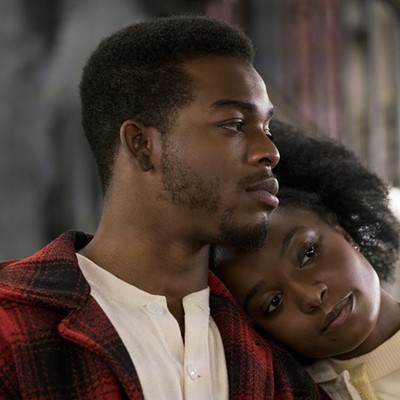When you look back at most of the really powerful movie romances both past (City Lights, Gone with the Wind, Casablanca) and present (Love Story, Annie Hall, Witness), they usually concern lovers who were made for each other but, for a variety of reasons, can't live together. Maybe they're so strong willed they'd tear each other up. Maybe there's a cultural or economic wall between them. Or maybe they're just too deeply in love to be happy together.
In any case, they have to part with sweet sorrow, usually at a train station or airport, and usually during a rain shower; images of their magical time together are fixed in their memory like a flower trapped in amber. They can look back at it and get misty-eyed, reveling in what was and ignoring what might have been.
I've just described the plot of The Bridges of Madison County, the film version of the best-selling book by Robert James Waller. In case you've been trapped in amber for the past few years, the story is about an Italian-born farm woman named Francesca Johnson (Meryl Streep) living in small-town Iowa. She has two teenage children, a devoted husband and a satisfying (if fairly uneventful) life as a homemaker.
But when her husband takes the kids to another county for a few days to attend a livestock show, leaving Francesca alone in the farmhouse, her introspection turns depressive. Did she abandon her youthful dreams of adventure too easily? Did she cheat herself of a wild, energetic life to embrace something more domestic -- something safe?
She gets an answer when a rugged photographer named Robert Kincaid (Clint Eastwood) pulls up in a battered pickup and asks her to point the way to one of the covered bridges of Madison County he's supposed to shoot for a National Geographic story. Although he's a well-traveled man who has divested himself of nearly every possible emotional entanglement, he shares with Francesca a slyly ironic, deeply philosophical outlook on life. Soon, they're moving toward an affair.
The movement is slow and hesitant, and so polite that it's rather courtly. Screenwriter Richard LaGravenese specializes in creating people who are happy on the outside but lost and alone within, and he's managed to pare Waller's rather turgid little book down to its barest emotional essentials. Robert and Francesca have only four days together, and it's the most intense four days of their respective lives, even though nothing overtly exciting happens.
But what happens between the actors is exciting indeed. Eastwood, who directed the picture, creates a vast but enclosed space of intense quiet, broken only by the whir of cicadas or the rumble of a car engine; for the first half-hour of the movie, the only music comes from radios, and he lets Robert and Francesca's courtship unfold in a series of long takes, mostly in medium shot.
The movie is so respectful of the quieter pleasures in life -- a cold beer after a hot day, satisfied smiles after a filling meal, the rustle of grass and flowers clinging to an interstate shoulder -- that at times Bridges has less in common with other American romances than with films by foreign masters such as Michelangelo Antonioni. Eastwood's movie is warmer, of course, and more full of life. Eastwood savors the awkward pauses between sentences, and the way the two would-be lovers fidget and look away and cryptically smile, letting body language tell us what words they're hiding.
The result is one of the most restrained, respectful and scrupulously intelligent romances I've ever seen in a movie. Bridges is a hard film to write about, because what doesn't happen -- the impulses not acted upon, the declarations of love not spoken -- is just as important as what does happen. You'd be better off trying to describe the smell of summer air in the Midwest, the bittersweet taste of brandy on the tongue or the goose pimples that rise on your arm the first time you touch someone you desire.
A less confident director might have oversold the movie; he might have put too much faith in flattering lighting, swelling music and pastoral sex scenes and not enough in solid dialogue and expert acting. In that light, it seems ironic and yet appropriate that one of the most unabashedly sentimental bestsellers of recent years should have been entrusted to one of the least sentimental men in American cinema.
Eastwood doesn't hype either himself or his co-star. He shoots his ruddy, craggy, gray-haloed head and Streep's rounded, slightly chunky face the way he shoots the landscapes in all of his Westerns, bringing out their inherent beauty without artificially altering their physical natures. It's a perfect approach for this story, which is about uncovering the adventurer inside seemingly staid people. If you're a patient viewer who doesn't mind a story that takes its time and doesn't spell out big meanings in block letters, you'll be especially appreciative of what Eastwood has done -- and probably equally annoyed by the film's rendition of an awkward framing device in which Francesca's now-grown kids read of their mother's affair in her journals. A film whose meanings are so clear doesn't need italics.





